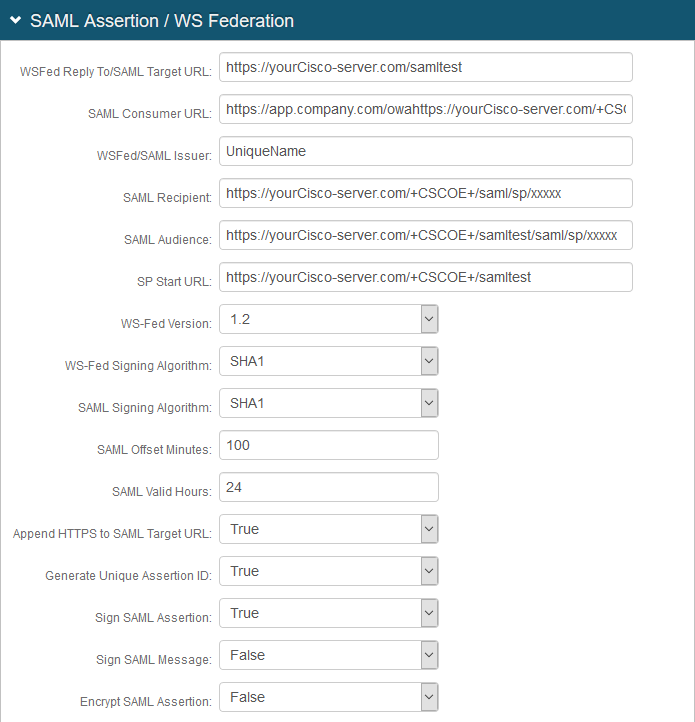Cisco AnyConnect VPN on ASA (IdP-initiated) integration guide
Introduction
Use this guide to integrate Cisco AnyConnect VPN (SAML) with SecureAuth IdP on Cisco Adaptive Security Appliance (ASA).
Prerequisites
SecureAuth IdP version 9.1 or later with a realm ready for the Cisco ASA integration
Cisco account
Supported on Cisco ASA version 9.7.1 or later for both AnyConnect client and clientless SSL VPN
Cisco ASA configuration steps
This section provides the information you need to configure SecureAuth IdP on Cisco ASA.
1. Log in to the Cisco ASA box.
2. From the command line, run the following commands below and in the remaining steps:
– sh run webvpn saml
3. Create a SAML identity provider, where UniqueName can be any name. This name is used in the SecureAuth IdP configuration section for the WSFed/SAML Issuer field on the Post Authenticaton tab.
saml idp UniqueName
4. Configure the SecureAuth IdP URLs.
url sign-in https://yourVPNaddress.com/SecureAuth#
url sign-out https://yourVPNaddress.com/SecureAuth#
5. Configure the Clientless VPN base URL.
base-url https://yourCisco-server.com/samltest
6. Configure trustpoints between the SecureAuth IdP and ASA.
trustpoint idp UniqueName
trustpoint sp asa_saml_sp
7. Configure SAML timeout.
timeout assertion 7200
SecureAuth IdP configuration steps
1. Log in to your SecureAuth IdP Admin console.
Post Authentication tab
2. Select the Post Authentication tab.
3. In the Post Authentication section, make the following entry:
a. Set Authenticated User Redirect to SAML 2.0 (IdP Initiated) Assertion.
 |
4. In the User ID Mapping section, make the following entries:
a. Set User ID Mapping to Authenticated User ID.
 |
5. In the SAML Assertion / WS Federation section, make the following entries:
a. Set the WSFed Reply To / SAML Target URL to the absolute URL of the application, to where end-users are redirected upon successful authentication.
For example, https://yourCisco-server.com/samltest
b. Set the SAML Consumer URL to the Cisco URL used to accept a SAML assertion.
For example, https://yourCisco-server.com/+CSCOE+/saml/sp/xxxxx
c. Set the WSFed/SAML Issuer to a unique name that identifies the SecureAuth IdP to the application (as the SAML ID).
This value is shared with the application and can be any word, phrase, or URL, but must match exactly in the SecureAuth IdP and Cisco ASA configurations.
For example, UniqueName is used in step 3 of the Cisco ASA configuration steps
d. Set the SAML Recipient to the identifiable information of the SAML Recipient, which usually maps to the SAML Consumer URL.
For example, https://yourCisco-server.com/+CSCOE+/saml/sp/xxxxx
e. Set the SAML Audience to the base domain of the application.
For example, https://yourCisco-server.com/+CSCOE+/samltest/saml/sp/xxxxx
f. Set the SP Start URL to the login URL for the application.
This value enables appropriate redirection for normal login and SSO login experiences.
For example, https://yourCisco-server.com/+CSCOE+/samltest
 |